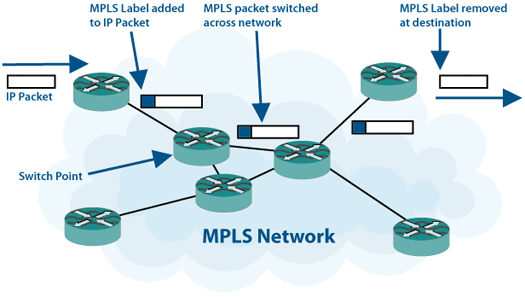MPLS Technologies
When it comes to network performance, consistency is king.
Whether you are an end-user in search of predictable latency or an ISP looking to provide your customers with reliable, consistent service, you’re most likely already utilizing or considering MPLS as a solution.
Multiprotocol Label Switching (MPLS) is a data-carrying mechanism of applying ‘labels’ to data packets. The existence of this label optimizes packet forwarding decisions and allows for many different media types to coexist in the MPLS network, eliminating reliance on any one specific data link protocol.
This allows a provider to deliver private WAN services over Ethernet, DSL, Frame Relay, and other technologies as appropriate to the location and existing infrastructure. Additionally, since the label is used for forwarding and not the L3 information, packets from customers’ private networks can be transported seamlessly across the provider network without needing to use any tunneling protocol.

For the End User
MPLS services for the end user rarely require any additional capability aside from basic routing features. All the MPLS tagging and traffic segmentation is performed by the provider transparently to the end user. Because of this, virtually any of Cisco’s small router line-up can be appropriate for a customer edge router.
Select routers based on the throughput needed, interface needed, and any additional security features needed.
End-User products
| Cisco1841 | |
| Cisco2811 | |
| Cisco2821 | |
| Cisco2801 |
For the Service Provider
Deploying MPLS services to the customer base does require hardware that is aware of the MPLS tag and can make forwarding decisions based on this tag. Label Switch routers, the core MPLS forwarding devices, usually have minimal requirements beyond this basic awareness — they merely inspect the label and forward it on. At the provider edge/LER, though, additional hardware and software requirements may exist based on the services to be provided.
At the provider edge, common products are the ME series switches (with ME-C3750 being very popular) and 7600 series routers once again, though here with higher end cards like the SIP and SPA combinations.
| ME-3400G-12CS-A | |
| ME-3400G-2CS-A | |
| ME-3400-24FS-A | |
| ME-4924-10GE |
At the provider core, commonly used platforms are the CISCO7600 series, 12000 series, and XR 12000 series, with the CRS series seen in this role at the largest provider networks.
| Cisco7609 | |
| RSP720-3C-10GE | |
| WS-X6748-SFP | |
| PWR-4000-DC |
Extend the life of your MPLS network with NetSure from Curvature.
Our complete network coverage solution is customized to your network and budget needs. Save as much as 50-90% on hardware maintenance without compromising your network performance.
MPLS Terminology
Label Edge Router (LER)
The router that provides the customer-facing interfaces and adds/removes the MPLS labels.
Label Switch Router (LSR)
The routers that make up the provider’s core network and make forwarding decisions on the MPLS label.
Label Distribution Protocol (LDP)
A protocol used by MPLS-participating routers to exchange MPLS label information and determine the next hop for the labeled traffic. LDP is a very simple protocol without much in the way of advanced capabilities, and is not used much anymore.
MPLS Traffic Engineering (MPLS-TE)
A much more advanced means of determining label paths, MPLS-TE allows for label paths to be determined dynamically with input through the IGP in use (either OSPF or IS-IS), creation of static end to end tunnels, and through RSVP, can provide QoS for traffic traversing the provider network.
